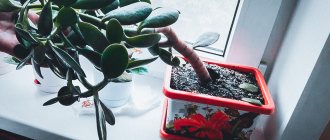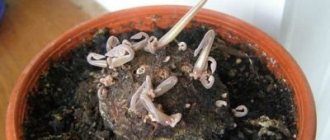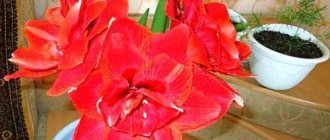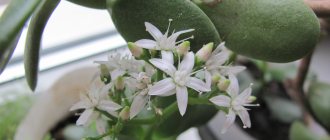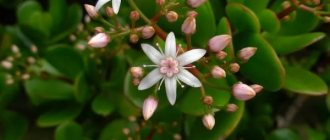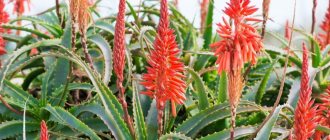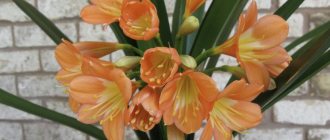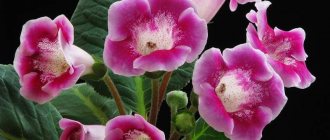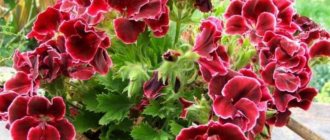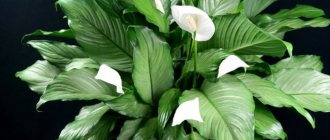A poinsettia flower in its bloom is a very beautiful sight, but short-lived. Since ancient times, it has been considered a symbol of home prosperity and comfort. This plant, originally from Mexico, is well known to plant growers as the most beautiful euphorbia .
But people most often call it the “ Christmas star .” Because it is during the Christmas period that its bright flowers from the leaves begin to “light up” brightly on our windowsills.
Caring for poinsettia requires the creation of favorable conditions. Then it will not cause you much trouble and will prolong its flowering. This beauty will always be an excellent gift for yourself and loved ones, and using the tips below, you can turn it into a perennial that will delight you with its beauty every Christmas.
What does it take to achieve flowering?
If you grow poinsettia at home and do not follow the nuances of caring for the plant, you may not wait for the poinsettia to bloom. There is a whole instruction, the exact implementation of which leads to the fact that the most beautiful milkweed will definitely bloom on the eve of the New Year holidays.
How to “light” a Christmas star on a windowsill?
In its natural environment, poinsettia blooms in conditions of short daylight and long night. How to make a plant bloom at home? It is necessary to artificially create a lighting regime similar to natural.
Start limiting daylight hours from the end of September. From six to seven o'clock in the evening, put the poinsettia in a closet or cover it with a dark box that does not let in light. It is necessary to hide the plant from light until seven to eight o'clock in the morning. Poinsettias should be kept in the dark for about 14 hours a day.
During the day, place the plant in the brightest place. Water and spray as usual. Fertilize regularly. Keep the poinsettia in such conditions for eight to ten weeks.
Important! The darkening must be absolute, otherwise the bracts will be unevenly colored.
As soon as flower buds appear and signs of coloring of the bracts are noticeable, stop darkening. Stop feeding. If these conditions are met, the poinsettia will definitely bloom by Christmas. To increase flowering time, keep the temperature slightly lower than normal.
What is the name of a flower with red leaves?
The red leaves of the flower are called inflorescences - this is modified foliage. The bracts can last from 2 to 6 months on the stem. And if you buy a flower, take one whose buds have not yet bloomed. Poinsettia does not tolerate drafts and low temperatures, nor does it tolerate direct rays of the sun.
Interesting materials:
How to connect tricolor without a receiver? How to connect tricolor through a router? How to connect Tricolor TV via the Internet? How to connect Tricolor TV to an old TV? How to connect the troika to the phone? How to connect digital cable TV to your TV? How to connect digital television for free without a set-top box? How to connect digital television without an antenna? How to connect digital television without cable? How to connect digital television via antenna?
The process of bud formation
The regime of artificially created short daylight hours leads to the formation of flower buds on the plant. Poinsettia flowers are small and inconspicuous and can be pink, yellow-green or white. After the formation of flower buds, in late November - early December, the coloring of the bracts begins.
This is the name given to the leaves located around the inflorescence. They are assembled into a rosette shaped like a star. It is the bracts that create the spectacular appearance of poinsettias during the flowering period.
The leaves can be bright red, white-pink, lilac, cream or white. The plant appears in all its glory by the end of December. Hence another name for poinsettia - Christmas star. The color of the bracts lasts up to six months.
Popular varieties
The most beautiful euphorbia is a plant from hot countries, its homeland is the tropics of Mexico and Central America. Under natural conditions, the height of the bush reaches 3.5–4 m, but for growing indoors, breeders have developed smaller indoor poinsettia varieties: only 30–50 cm. Despite its small size, the “Star of Bethlehem” always attracts attention and delights with its bright colors.
Characteristics:
- evergreen tropical shrub from the Euphorbiaceae family;
- the leaves look like an ellipse, from 10 to 15 cm long, often with an edge and stalks, the color is dark green;
- species: with red, white, yellowish, salmon-orange, pink bracts, variegated plants. The most popular are scarlet tops;
- Bracts of bright red color surround small inflorescences. Most people think that the scarlet “Star of Bethlehem” at the top of the plant is a luxurious flower, but it is just a bract. If you look closely, you can see inconspicuous greenish-yellow inflorescences framed by rich colors;
- flowering occurs during the Christmas period. In the winter cold, the blazing “Bethlehem” star appears. It is no coincidence that this name is popular and well known. The beautiful spurge is often called the “Christmas Star”;
- It’s hard to resist the spectacular appearance of such an unusual flower as poinsettia. Photos of a beautifully flowering plant are impressive. “Star of Bethlehem” often gets into the TOP - 10 most beautiful indoor flowers along with begonia, house rose, Decembrist, azalea;
- propagation at home is carried out by cuttings;
- after the flowering period, a small bush may die, but if the rules of care are strictly followed, the plant turns into a perennial;
- Like other plants from the Euphorbiaceae family, poinsettia exudes a milky sap when cut; the liquid is poisonous. Do not allow milky juice to get into your eyes, mouth, or skin: allergic reactions and intestinal upset are possible. For this reason, pruning and other operations with stems and leaves are carried out using medical gloves and precautions are taken. It is necessary to protect the flower from pets because of the poisonous juice.
The rich red hue of the bracts is not the only one, as many believe. Breeders have developed several hybrid varieties with top elements of yellow, pink, and white. Two-color and variegated “false petals” look original.
Popular cultivated varieties and hybrids:
- Oak Leaf. The reddish-orange bracts are similar to the leaves of American oak.
- Premium Red. Intense red bracts, small yellow flowers in the middle.
- Cortez Burgundy. Purple apical stipules.
- Cortez Red. Scarlet bracts with green veins.
- Winter Rose. Curved, lush “petals” of a yellowish-cream hue with a pinkish center.
- Freedom Jingle Bell. The original bracts are pale pink, with a coral tint and a light green border around the edges.
- Polar Bear. White poinsettia with delicate bracts. The lower leaves have greenish veins.
- Sonora Marble. Variegated variety: the upper bracts combine light yellow and pink, the lower ones are completely green.
- Tapestry. Bright scarlet bracts, lower leaves of a “fresh” green color with an uneven yellowish border at the edges.
- Cinnamon Star. Hybrid variety with orange-salmon tint of bracts. After a while, a light reddish coating appears on the surface.
- Jingle Bells. The “first snow” is scattered on the carmine-red leaves - specks of cream and white tones.
Care during the rest period
Usually by the end of March the poinsettia has finished blooming, what should I do next?
- It is necessary to stop fertilizing and gradually reduce watering.
- When the bracts wither and the lower leaves begin to fall off, you should trim all the stems, shortening them to ten centimeters. Leave three to five healthy buds on each shoot, which will provide new growth and become the basis for future flowering.
- Then the poinsettia is sent to rest. It is necessary to move the plant to a dry, shaded room, where it will be at a temperature of +14 to +16°C. Indicators should not fall below +10°C. The rest period lasts one and a half to two months.
- At this time, poinsettia practically does not need watering. In order not to completely dry out the soil, you should very rarely and carefully feed the plant with water through a tray. Don't forget to pour out excess moisture. Overmoistening of the substrate leads to rotting of the root system and above-ground parts of the poinsettia.
Transfer
It is recommended to replant a young flower in the spring and every year, and an adult - once every 3-5 years. This is April or May. Before this event, the stems should be cut by a third, with 3-5 of the most developed buds left on each shoot.
After dormancy, the poinsettia is transferred to a bright and warm room, watered with warm water. Only after the first leaves appear is the plant transferred to a new container.
Step by step:
- Disinfect the container with a manganese solution;
- Place 3 cm of drainage made of pebbles, gravel or expanded clay at the bottom of the pot;
- Add soil;
- Carefully pull the bush out of the old pot;
- Transfer to a new pot, 2 cm larger than the previous one, add soil;
- Water and transfer to the windowsill.
When new shoots appear, it is necessary to leave 5-6 of the strongest and strongest shoots and remove the weak ones. Very soon you will have a beautiful curly bush “Christmas Star”.
Do I need to move it to another pot after purchase?
The pot you bought in does not have soil suitable for permanent residence of the flower. But there is no need to replant immediately. Let it sit in this pot for a month, and then replant. The flower adapts and will tolerate transplantation well.
Don’t forget to fill the pot with sand over the drainage and put vermiculite.
Poinsettia pot
The potted flower likes to grow in good soil, and the pot can be chosen from ceramic or plastic. It is important that it is 1.5-2 centimeters larger than the old one, so that the roots are not too crowded.
Priming
You can buy ready-made soil. Or you can prepare it yourself by making a mixture: 2 parts leaf soil, 1 part sand and 1 part dry manure.
What to do if the plant does not take root
Why doesn't the flower take root? The cause may be root damage or rotting. It is necessary to remove the plant from the pot and treat it with one of the preparations (Kornevin, Radifarm, Ribav, Epin).
If the root is rotten, then you need to cut off the rotting shoots and treat the root with Fitosporin-M or Discor. Next, planting is carried out in a new disinfected pot.
Why is the plant “capricious”?
Poinsettia is a rather capricious plant. She refuses to bloom for various reasons:
- lack of light and heat;
- dry indoor air;
- irregular watering;
- stress due to a change of place during the formation of buds;
- no pruning;
- inadequate feeding;
- pot size is too large;
- no rest period.
Why don't the leaves turn red?
Gardeners love this ornamental plant because of the red bracts that burst into color as the buds form. In indoor conditions, leaves fade due to inappropriate light conditions, this is considered the most common reason. Problems are also possible due to:
- too infrequent watering;
- cold;
- low air humidity;
- a new place where the pot was placed during flowering.
How to properly care?
Let's look at how to properly care for poinsettia so that it blooms. Optimal conditions should be created for the plant:
- Organize good lighting. In April - May, after a period of rest, place the poinsettia in the brightest place. Windows facing south and southeast are ideal for this.
- Maintain high air humidity - from 60 to 90%. Spray the area around the Christmas star with warm water from a spray bottle every day. Do not allow moisture to get on the leaves - they will become stained.
- Keep at average air temperature. Heat is contraindicated for the plant. The optimal temperature in summer should be from +20 to +25°C. In too cold a room, poinsettia stops growing and does not bloom. It is necessary to protect poinsettia from sudden temperature fluctuations, otherwise the plant will shed its leaves.
- Protect from drafts. Poinsettias lose their foliage even after short exposure to cold air.
- Water regularly twice a week as the top layer of soil dries. Use soft water that has been standing for several days. Make sure that moisture does not stagnate in the pan. In autumn, watering should be gradually reduced. In winter, carry out the procedure only once a month.
- Choose a pot that is not too large for your poinsettia. Otherwise, a lot of moisture accumulates in the container and the roots begin to rot. When initially planting, take a medium-sized pot. In the future, replace the tank with a larger one each time. The new pot should be two to three centimeters larger than the previous one.
- Keep poinsettia in loose soil that allows moisture and air to pass through. The optimal soil acidity is from 5.8 to 6.6 pH. A ready-made substrate is suitable for decorative foliage plants. You can form the soil yourself by mixing turf, leaf soil, peat and river sand in a ratio of 3:3:1:1. Before use, such soil must be sterilized with a weak solution of manganese.
In the spring-summer season, apply fertilizer every two weeks. In order for them to be well absorbed, it is better to alternate organic and mineral supplements. Strictly follow the concentration indicated on the package, otherwise you may harm the plant. Until the very moment of flowering, the most beautiful milkweed requires fertilizers with a high content of phosphorus and potassium.- A young plant should be replanted annually, and after reaching the age of three years - every two years.
- Do not replant poinsettias while they are in bloom. The procedure must be carried out after the end of the dormant period, when young leaves appear on the branches. The best time for transplantation is April and May. In this case, use the transshipment method - do not free the root system from the old substrate. This will protect the delicate roots of the poinsettia from damage.
- Give the plant a good rest every year after flowering has finished.
- Be sure to prune twice a year. The first procedure should be carried out after flowering - before the dormant period. The second - in April, after the transplant.
Propagation of poinsettia by cuttings at home
"Christmas Star" propagates vegetatively from apical (apical) cuttings. They can be cut after a rest period at the beginning of active growth, from about May to July, or during pruning. The length of the cuttings is 10-15 cm and they should have at least 2-3 fully developed leaves.
After cutting, the cuttings are placed in warm water for a couple of hours to allow the milky juice to drain, and then placed in a damp mixture of peat and sand in a 1:1 ratio. You can also use perlite instead of sand.
Before planting in the ground, it is recommended to immerse the tips of the cuttings in a root growth stimulator.
To create warm and humid conditions, cover the pot with a plastic bottle or film. During rooting, it is necessary to remove the cover once a day for ventilation and monitor moderate soil moisture.
Rooting usually takes 3-4 weeks. About a couple of weeks after the roots have formed, the seedlings can be transplanted into pots with fertile soil.
Euphorbia sheds its lower leaves: what to do after this?
After flowering, the bracts turn green, then turn pale and fall off. The plant loses its decorative effect. The poinsettia then sheds its lower leaves, exposing the trunk. Some inexperienced gardeners decide that the plant is dead and get rid of it. In fact, poinsettias require pruning and rest before they will resume growth and be ready to bloom again.
We talked about what to do if the poinsettia gets sick and sheds its leaves in December, as well as about various diseases and pests of the plant in our material.
Poinsettia can be induced to bloom by creating a regime of short daylight and long night. With proper care, the Christmas star will delight you with its bright leaves on New Year's Eve, creating coziness and a festive atmosphere in the room.
Diseases and pests
Poinsettias can be attacked by insects. For example, mealybug, whitefly, spider mite, scale insect. If aphids or scale insects are noticed on the leaves, they can be washed with soapy foam and then rinsed in the shower.
With a large number of pests, a difficult period begins for the growth and development of bushes. To get rid of them, you need to treat them with drugs, following the instructions.
